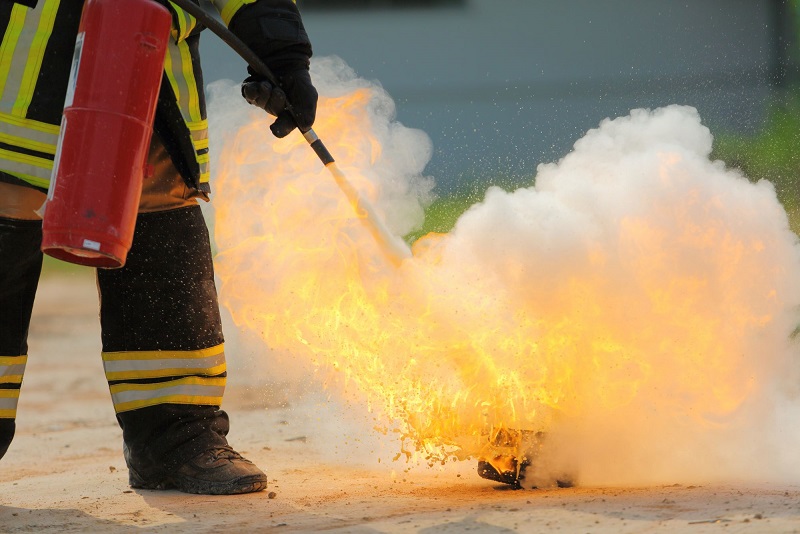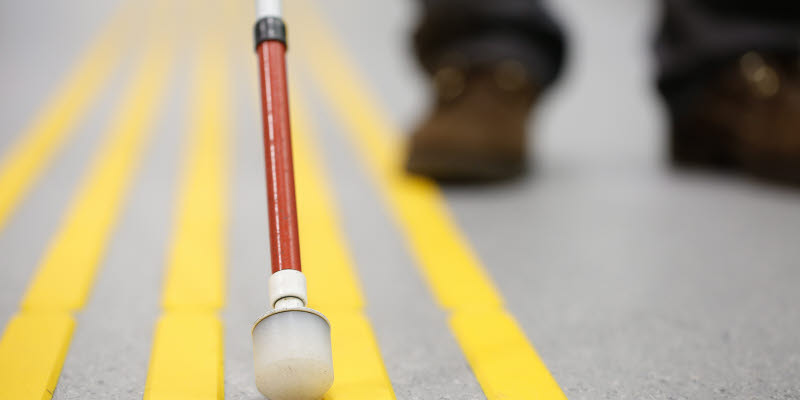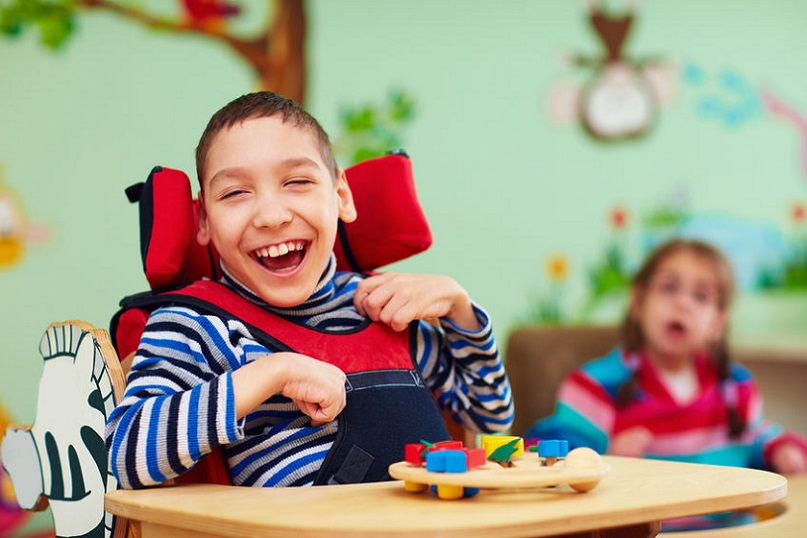We put this massive infographic together on fire safety for disabled persons, and spent more than 53 hours doing so.
We hope that it helps you and that you will share it with whoever could find it useful.
We also invite you to see our other infographic on fire safety for kids right here.

Everything You Need to Know Related to Fire Safety and People With Disability
Rather than make a guide that is very repetitive explaining each step for the different disabilities (blindness or low vision, deaf or hard-of-hearing, physical disabilities or cognitive impairments), we have decided to combine the universal steps beneath and then include the disability-specifics steps under their own section.
Knowing how to limit the risk of starting a fire as well as knowing exactly what to do if a fire does in fact break out, that you cannot keep under control, is crucial and will significantly lower the risk of being injured; for the person with the disability, knowing these steps is even more important.
According to the National Fire Protection Association, roughly 3,400 people deaths and 16,000 injuries caused by fires in the United States alone. At the same time, fire caused $11.5 billion in property damage in 2013.
Fires are dangerous for everyone, but for people with disabilities, the risk is even greater. One issue is that people with disabilities may have a harder time escaping during a fire, but at the same time, the risk of starting a fire is also significantly bigger for certain types of disabilities. Considering this, it is especially important for people with disabilities or their caregivers to be aware of steps taken to prevent fire, how to create and practice the right fire escape plan and what to do following a fire.
With this in mind, we decided to create the most extensive, easy to understand and appealing fire safety guide for people with disabilities and their caregivers. We’ve also chosen to have specific sections dealing with what to do in case you or someone you know is the caregiver for a person with disabilities. This article and the infographic below is made to help caregivers with the right steps to take to minimize the risk of causing and getting injured during a fire.
Universal ways to prevent fires

- When cooking over an open flame, wear tight-fitting clothes to avoid them catching fire.
- Don’t leave hot pans unattended when cooking.
- Pot handles need to face away from the edge to avoid them being knocked on the floor.
- Always set a timer when cooking in the oven.
- Overloading electrical outlets must be avoided.
- Use candles in a safe way.
- Avoid heating your home using the oven in your kitchen.
- Space heaters and chimneys need to be properly maintained.
- Be cautious of where you smoke. A lit cigarette may set fire to other things.
- Cooking surfaces must be kept clean to avoid grease buildup.
As you can see, a lot of these relate to the kitchen as this is usually where the fire starts.
Knowing the steps mentioned above is only part of it. You also need to prepare yourself so you know how to react in case a fire breaks out.
These are the universal steps to prepare against fire for persons with disabilities.
Universal fire preparation steps

- Make sure your escape plan has at least two exits out of each room.
- Practice the route at least twice a year, if more times is needed, practice more often.
- When exiting the building, stay low to the ground, even when practicing.
- Living on the ground floor, preferably near an exit will make it easier to escape if a fire breaks out
- Make sure your fire alarm can be heard and/or seen in any part of the home.
- Make sure that your fire alarm will in fact wake everyone up – a fire might break out when you’re asleep.
- Test the alarms monthly and change batteries at least once a year to ensure it always working.
- Essential items (walkers, canes, glasses, or hearing aids need to be close by you at all times, also when asleep).
- Changing address? Make sure to go through all the steps again.
Now you know how to prepare yourself in case of a fire, but here’s what you’ll need to do, if a fire does break out – though we hope it won’t happen!
Universal steps in case of a fire

Here’s what to do in case of a fire:
- Follow the escape plan while staying near the ground to avoid breathing in excess amounts of smoke.
- Always check doors with the back of the hand before opening them. If a door is hot, do not open it. It might be a sign there’s a fire behind the door, instead use another exit.
- Don’t use the elevator during a fire unless explicitly advised by the fire department.
- Once you’re outside, call 911.
- Afterwards, let your friends and family know everyone’s okay.
Fire safety guide for persons with blindness or low vision

According to Disability Statistiscs 6.6 million Americans are visually impaired or blind. Living with either, a person is at higher risk for both causing fires and getting injured during a fire. They may accidentally start fires, and if trying to put out a small fire, being burned is also easier.
Things to remember for the blind or visually impaired
- Got a service animal? Make sure to practice the escape route with your service animal.
- Get a fire alarm that pauses between alarm cycles to be able to hear instructions from a firefighter.
Especially for parents with visually impaired children
- Make sure to practice “Get low and go”, so your children know the importance of staying low while making their way to an exit.
- Children need to be familiar with the sound of the smoke alarm so they know what it means and make sure they wake up from it at night too.
- The local fire department should be informed that there is a visually impaired child in the home, so they can adjust their rescue efforts accordingly.
SafeKidsUSA has made a four-step plan for parents to follow with their visually impaired children:
- Create an escape plan with at least 2 ways out of each room.
- Establish a convenient meeting place outside the building.
- Once outside, call 911.
- Practice the plan at least twice a year, more often if needed.
Fire safety guide for persons who are deaf or hard-of-hearing

In the U.S, approximately 4 million people have a hearing disability.
Be sure to follow the same universal fire prevention steps explained above.
In addition to following the universal steps to stay prepared, the deaf and hard-of-hearing are at risk as they may not be able to hear a traditional smoke alarm, and this requires the following precautions.
- Get a specially designed smoke alarm with flashing strobe lights. Vibrating pillow pads and bed shakers should also be purchased.
- The alarms need to be visible from anywhere in the house, so the deaf or hard-of-hearing person will know of the fire immediately.
- Always keep your TTY/TDD, hearing aids and similar devices nearby.
- Make sure to inform the fire department that a person in the home is deaf or hard-of-hearing so they’ll know how to better handle the situation in case of a fire.
Especially for parents of children who are deaf or hard-of-hearing
- Make sure that flashing/vibrating smoke alarms are installed, and that children know what they mean.
- Test alarms frequently.
- Make sure your child will wake up if the alarm goes off while they’re asleep.
- Make sure to practice “get low and go” when practicing the escape route.
- Teach children what firefighter look like. Otherwise, they might be afraid when they see them when there’s a fire.
- The local fire department should be informed that a child in the home is deaf or hard-of-hearing.
Fire safety guide for persons with physical disabilities

In the United States, there are about 700 home fires involving people with physical disabilities every year. When it comes to fires, people with physical disabilities are especially at risk as
- homes may not be designed in a fashion that makes it easy for people with disabilities to escape. There might obstacles making the escape route hard to maneuver.
- physical disabilities can make it hard to escape quickly for a number of different reasons.
In terms of fire prevention, persons with physical disabilities need to follow the universal fire prevention steps explained earlier. On top of the universal fire safety steps, there are additional steps needed for a physically disabled:
- Living on the floor, next to an exit is especially important for those living with physical disabilities.
- Make sure wheelchairs and walkers fit through all exits.
- If it is necessary, there should be a ramp near emergency exits.
- Local fire departments should be aware of a person living with physical disabilities, as it’ll help them in the event of a fire.
- Coworkers need to know how to assist during a fire if the physically disabled needs help making the escape route.
- Are there any obstacles that would make it hard for a physically disabled person to escape? Make sure to report these.
If there has been a fire, it’s important the physically disabled person checks his belongs (wheelchair or walker) to be sure everything is still undamaged.
Especially for parents with visually impaired children
- Your child should have fire escape plans for all the places frequently visited. This can include but is not limited to home, school, friends’ homes etc.
- Does your child need assistance to get out in case of a fire? Make sure there are designated adults that can help.
- Make sure to practice stop, drop and roll. This can smother flames if clothing catches fire.
Fire safety guide for persons with cognitive impairments

In the United States, there are about 1700 home fires involving people with cognitive impairments every year. People with cognitive impairments are at high risk during a fire. Similarly, the most important thing to protect them is by being aware of all the fire prevention steps.
As mentioned earlier, many home fires start in the kitchen. Depending on the severity of the cognitive impairment, avoiding or limiting cooking using the oven or stove can be a good idea.
Here’s a list of things to be especially careful of in the kitchen to avoid fires breaking out:
- Double check the proper cooking level of stove burners.
- Properly store flammable items (such as paper towels) that catch fire easily.
- Triple check the oven and stove burners are turned off after finishing cooking.
- Loose clothing is to be avoided during cooking
- Pot handled must be turned in to make it harder to knock them on the floor.
- Inappropriate items such as metal must not be placed in the microwave.
These are the most important things to consider in a kitchen.
Always follow the universal steps when preparing against fire, but depending on the severity of the cognitive impairment the National Fire Protection Association also advises the following:
- The person with the cognitive impairment might not at first understand the sound of the smoke alarm. If this is the case, practice the escape route sufficiently often for the person to learn its meaning. Teach them what to do when they hear it.
- Is the person able to follow the escape plan?
- If needed, decide ahead of time, who will provide the necessary assistance. Preferably, two people should be assigned the task.
- Escape routes should be marked so the person understands what they must do, this might be achieved by placing exit signs above the door.
- Rehearse the escape plan sufficiently often to make sure the person with cognitive impairment does not forget the different steps.
- The local fire department needs to know about the person with cognitive impairment, and how to make sure to handle the situation so the cognitively impaired does not get unnecessarily scared.
If a fire breaks out, it may psychologically impact the person. Be sure to talk about the event in a way that helps the person with cognitive impairment to not be afraid of the event.
If you need to move, it’s essential that all the steps are repeated, and consider working with a contractor to get it done easily.
Especially for parents of children who have cognitive impairments
Safe Kids Worldwide recommends these steps:
- The escape plan has to have at least two exits out of each room.
- Explain the different steps using the child’s strengths
- Using visuals may sometimes help.
- Use signs to help your child know what to do.
- Establish a meeting place outside of your home
- Once outside, call 911
- As the child may have difficulty remembering the different steps, it’s important to practice everything often.
We advice people in contact with persons with disabilities to read through this infographic on fire safety for disabled persons regularly to be able to provide appropriate assistance.